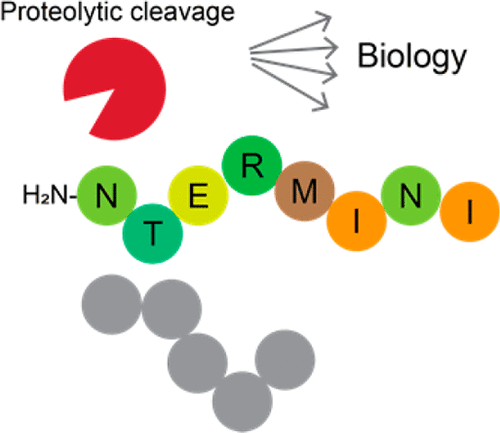当前位置:
X-MOL 学术
›
Chem. Rev.
›
论文详情
Our official English website, www.x-mol.net, welcomes your feedback! (Note: you will need to create a separate account there.)
Proteolytic Cleavage—Mechanisms, Function, and “Omic” Approaches for a Near-Ubiquitous Posttranslational Modification
Chemical Reviews ( IF 62.1 ) Pub Date : 2017-12-21 00:00:00 , DOI: 10.1021/acs.chemrev.7b00120 Theo Klein 1 , Ulrich Eckhard 1 , Antoine Dufour 1 , Nestor Solis 1 , Christopher M. Overall 1
Chemical Reviews ( IF 62.1 ) Pub Date : 2017-12-21 00:00:00 , DOI: 10.1021/acs.chemrev.7b00120 Theo Klein 1 , Ulrich Eckhard 1 , Antoine Dufour 1 , Nestor Solis 1 , Christopher M. Overall 1
Affiliation

|
Proteases enzymatically hydrolyze peptide bonds in substrate proteins, resulting in a widespread, irreversible posttranslational modification of the protein’s structure and biological function. Often regarded as a mere degradative mechanism in destruction of proteins or turnover in maintaining physiological homeostasis, recent research in the field of degradomics has led to the recognition of two main yet unexpected concepts. First, that targeted, limited proteolytic cleavage events by a wide repertoire of proteases are pivotal regulators of most, if not all, physiological and pathological processes. Second, an unexpected in vivo abundance of stable cleaved proteins revealed pervasive, functionally relevant protein processing in normal and diseased tissue—from 40 to 70% of proteins also occur in vivo as distinct stable proteoforms with undocumented N- or C-termini, meaning these proteoforms are stable functional cleavage products, most with unknown functional implications. In this Review, we discuss the structural biology aspects and mechanisms of catalysis by different protease classes. We also provide an overview of biological pathways that utilize specific proteolytic cleavage as a precision control mechanism in protein quality control, stability, localization, and maturation, as well as proteolytic cleavage as a mediator in signaling pathways. Lastly, we provide a comprehensive overview of analytical methods and approaches to study activity and substrates of proteolytic enzymes in relevant biological models, both historical and focusing on state of the art proteomics techniques in the field of degradomics research.
中文翻译:

蛋白水解切割—机制,功能和近乎普遍的翻译后修饰的“组学”方法
蛋白酶通过酶水解底物蛋白质中的肽键,导致蛋白质结构和生物学功能的广泛,不可逆的翻译后修饰。在降解组学领域,近来的研究通常被认为是破坏蛋白质或维持生理动态平衡的纯粹的降解机制,这导致人们认识了两个主要但出乎意料的概念。首先,通过广泛的蛋白酶库进行的有针对性的,有限的蛋白水解切割事件是大多数(即使不是全部)生理和病理过程的关键调节因子。其次,体内稳定裂解蛋白的数量出乎意料地显示无处不在,在正常和患病组织中具有功能相关的蛋白质加工-40%至70%的蛋白质也以具有未记录的N或C末端的独特稳定蛋白形式在体内发生,这意味着这些蛋白形式是稳定的功能裂解产物,大多数具有未知的功能含义。在这篇综述中,我们讨论了不同蛋白酶类别催化的结构生物学方面和机理。我们还提供了生物学途径的概述,这些途径利用特定的蛋白水解切割作为蛋白质质量控制,稳定性,定位和成熟中的精确控制机制,以及蛋白水解切割作为信号传导途径的介质。最后,我们提供了有关在相关生物学模型中研究蛋白水解酶活性和底物的分析方法和方法的全面概述,
更新日期:2017-12-21
中文翻译:

蛋白水解切割—机制,功能和近乎普遍的翻译后修饰的“组学”方法
蛋白酶通过酶水解底物蛋白质中的肽键,导致蛋白质结构和生物学功能的广泛,不可逆的翻译后修饰。在降解组学领域,近来的研究通常被认为是破坏蛋白质或维持生理动态平衡的纯粹的降解机制,这导致人们认识了两个主要但出乎意料的概念。首先,通过广泛的蛋白酶库进行的有针对性的,有限的蛋白水解切割事件是大多数(即使不是全部)生理和病理过程的关键调节因子。其次,体内稳定裂解蛋白的数量出乎意料地显示无处不在,在正常和患病组织中具有功能相关的蛋白质加工-40%至70%的蛋白质也以具有未记录的N或C末端的独特稳定蛋白形式在体内发生,这意味着这些蛋白形式是稳定的功能裂解产物,大多数具有未知的功能含义。在这篇综述中,我们讨论了不同蛋白酶类别催化的结构生物学方面和机理。我们还提供了生物学途径的概述,这些途径利用特定的蛋白水解切割作为蛋白质质量控制,稳定性,定位和成熟中的精确控制机制,以及蛋白水解切割作为信号传导途径的介质。最后,我们提供了有关在相关生物学模型中研究蛋白水解酶活性和底物的分析方法和方法的全面概述,


























 京公网安备 11010802027423号
京公网安备 11010802027423号